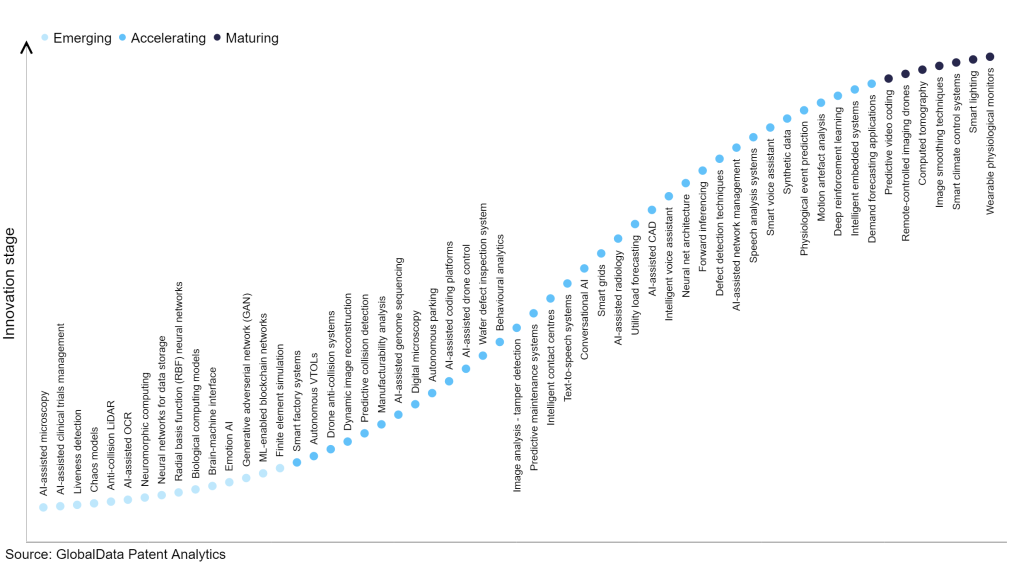The technology industry continues to be a hotbed of innovation, with activity driven by the rapid emergence and widespread adoption of game-changing technologies such as artificial intelligence (AI), advancements in deep learning algorithms, and growing importance of technologies such as reinforcement learning, neural networks, and neural architecture search (NAS). Generative adversarial network (GAN) may also integrate transfer learning to leverage pre-trained models or knowledge from related domains, accelerating training and improving the quality of generated outputs. In the last three years alone, there have been over 3.6 million patents filed and granted in the technology industry, according to GlobalData’s report on Innovation in Artificial Intelligence: Generative adverserial network (GAN). Buy the report here.
However, not all innovations are equal and nor do they follow a constant upward trend. Instead, their evolution takes the form of an S-shaped curve that reflects their typical lifecycle from early emergence to accelerating adoption, before finally stabilising and reaching maturity.
Identifying where a particular innovation is on this journey, especially those that are in the emerging and accelerating stages, is essential for understanding their current level of adoption and the likely future trajectory and impact they will have.
300+ innovations will shape the technology industry
According to GlobalData’s Technology Foresights, which plots the S-curve for the technology industry using innovation intensity models built on over 2.5 million patents, there are 300+ innovation areas that will shape the future of the industry.
Within the emerging innovation stage, finite element simulation, ML-enabled blockchain networks and generative adverserial network (GAN) are disruptive technologies that are in the early stages of application and should be tracked closely. Demand forecasting applications, intelligent embedded systems, and deep reinforcement learning are some of the accelerating innovation areas, where adoption has been steadily increasing. Among maturing innovation areas are wearable physiological monitors and smart lighting, which are now well established in the industry.
Innovation S-curve for artificial intelligence in the technology industry

Generative adversarial network (GAN) is a key innovation area in artificial intelligence
Generative adversarial networks (GANs) are unsupervised machine learning algorithms in the field of artificial intelligence, comprising a pair of neural networks engaged in a game-like competition. GANs are utilised to create new data when the availability of training data is limited.
GlobalData’s analysis also uncovers the companies at the forefront of each innovation area and assesses the potential reach and impact of their patenting activity across different applications and geographies. According to GlobalData, there are 230+ companies, spanning technology vendors, established technology companies, and up-and-coming start-ups engaged in the development and application of generative adversarial network (GAN).
Key players in generative adversarial network (GAN) – a disruptive innovation in the technology industry
‘Application diversity’ measures the number of different applications identified for each relevant patent and broadly splits companies into either ‘niche’ or ‘diversified’ innovators.
‘Geographic reach’ refers to the number of different countries each relevant patent is registered in and reflects the breadth of geographic application intended, ranging from ‘global’ to ‘local’.
Patent volumes related to generative adversarial network (GAN)
Source: GlobalData Patent Analytics
Stradvision is a leading patent filer in generative adversarial network (GAN). The company’s patents are aimed at invention describing a method for acquiring a sample image for label-inspecting among auto-labelled images for learning a deep learning network, optimising sampling processes for manual labelling, and reducing annotation costs.
The method includes a sample image acquiring device generating a first and a second image, instructing convolutional layers to generate a first and a second feature map, instructing pooling layers to generate a first and a second pooled feature map, and generating concatenated feature maps.
It also includes instructing a deep learning classifier to acquire the concatenated feature maps and generate class information, calculating probabilities of abnormal class elements in an abnormal class group, determining whether the auto-labelled image is a difficult image, and selecting the auto-labelled image as the sample image for label-inspecting.
The method can be performed by using a robust algorithm with multiple transform pairs. It also allows to detect hazardous situations more accurately.
Other prominent patent filers in the space include Samsung Group and Alphabet.
By geographic reach, Stryker leads the pack, followed by Cosmo Pharmaceuticals and Amgen. In terms of application diversity, Stryker holds the top position, followed by Enlitic and Heuron.
Generative adversarial network (GAN) in the field of artificial intelligence enables the generation of realistic and high-quality synthetic data, which is valuable for tasks such as data augmentation, content creation, and simulation. GAN also fosters innovation by pushing the boundaries of creativity and expanding the possibilities of AI-generated content in various domains. To further understand how artificial intelligence is disrupting the technology industry, access GlobalData’s latest thematic research report on Artificial Intelligence (AI) – Thematic Intelligence.
Data Insights
From

The gold standard of business intelligence.
Blending expert knowledge with cutting-edge technology, GlobalData’s unrivalled proprietary data will enable you to decode what’s happening in your market. You can make better informed decisions and gain a future-proof advantage over your competitors.







